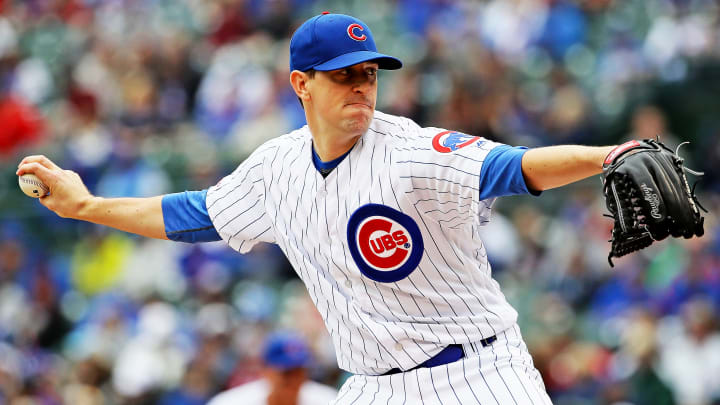No Longer as Predictable, Kyle Hendricks Has Become a Strikeout Threat Again

Kyle Hendricks won his fifth straight decision earlier this week, allowing three runs on six hits in seven innings against the Rockies. He walked just one while striking out 10, his second double-digit strikeout game of the season. Those 10 strikeouts jump off the page, and not only because any game with double-digit whiffs always catches the eye. In this particular instance, the 10 strikeouts serve as a capstone of Hendricks proving he’s an above-average strikeout pitcher.
An alarming trend from the previous two seasons continued through Hendricks’ first six starts this year. Over that time, he had a strikeout rate of 18.1%, putting him on pace for a strikeout rate decline for the third straight season. Hendricks did fan 11 batters in a win over the Diamondbacks in April, but that start was the anomaly. His strikeout rates for his other five starts in the stretch in question ranged between 9.5% and 19%, with four of the five coming in south of 15.5%. Hendricks, whose strikeout rate dipped below league-average for the first time in a full season last year, seemed to be cementing his status as a pure pitch-to-contact starter with little strikeout upside.
Over Hendricks’ most recent six starts, however, he has completely flipped that script. It started against the Marlins on May 8, when he fanned seven batters in eight innings. He has at least seven strikeouts in four of the five starts since, topped off by Tuesday’s 10-strikeout night against the Rockies. He’s whiffed at least 24.1% of the batters he has faced in five of the six outings.
His 26.5% strikeout rate in that span is 15.7% better than the league-average, which would be his greatest single-season divergence, by far. In 2015, his first full year in the majors, his strikeout rate was 8.1% better than league-average. The next year, when he led the majors in ERA and finished third in NL Cy Young voting, he was 10.7% better. In 2017, he was exactly average, and last year he fell off a cliff, ending the year 11.2% worse than league-average. His last six starts, then, are remarkable for two reasons. Not only do they reverse a recent, seemingly entrenched trend in his performance, they also represent the greatest strikeout run, relative to the rest of the league, of his career.

What’s behind Hendricks’ recent turn in the strikeout department? The first thing we had to consider was quality of opponent, but that doesn’t seem to be the case. Hendricks has faced the Reds twice, Marlins, Nationals, Astros and Rockies in his last six starts. The Rockies are the only team in the quintet with a strikeout rate more than 0.5 percentage points higher than league-average, the Astros are the second-hardest team in baseball to strike out, and none of them are easy to whiff. Based on this, Hendricks has earned his spike in strikeout rate. So, how has he done it? The answer may lie in pitch selection, specifically with two strikes.
Hendricks has long had one of the best changeups in the majors and he’s has never been afraid to use it. In every year of his career, he’s thrown his changeup at least 20.7% of the time. In each of the previous three seasons, his changeup usage rate was at least 26.7%, and this year it sits at exactly 27%. It has also been his best whiff pitch, registering swinging-strike rates between 19.9% and 26% over the first four years of his career. It’s down at 16.2% this season, but remains his offering with the highest whiff rate.
Kyle Hendricks, Nasty 79mph Changeup....and near smile as he emotionally strutted off the field after his 10th K/111th pitch. 😑 pic.twitter.com/V99BzLjCry
— Rob Friedman (@PitchingNinja) June 5, 2019
As good as Hendricks’ changeup is, there’s some evidence that his reliance on it has made him too predictable, especially with two strikes. Over his first six starts of the season, Hendricks threw his changeup 58.2% of the time in two-strike counts, registering a whiff rate of 17.9% in those situations. His overall whiff rate with two strikes was just 14.2% through his first six starts.
Since then, Hendricks has made a significant change in two-strike pitch usage. In his last six starts, his changeup has a usage rate of just 42.7% in two-strike counts. Meanwhile, his four-seam fastball, which he threw a measly 3.7% of the time with two strikes in his first six starts, has seen its usage rate skyrocket to 16.5%, an increase of 346%.
Kyle Hendricks, 87mph Fastball and 80mph Changeup, Overlay/Tails (regular speed). pic.twitter.com/rYfllN369k
— Rob Friedman (@PitchingNinja) May 30, 2019
That adjustment appears to be making all the difference. Over the period in question, Hendricks’ total whiff rate with the four-seamer is 17.9%, while the changeup’s whiff rate is 19.6%. Isolating for two-strike counts, the four-seamer has an 18.5% whiff rate, and the change is at 22.9%. His overall whiff rate in two-strike counts is up to a sterling 20.6%.
Predictability can be a pitcher’s greatest foe. By changing up his two-strike pitch usage, Hendricks is missing more bats than he has at any other point of his career. Combined with his longstanding ability to induce soft contact, Hendricks is enjoying a run of success we haven’t seen from him since he nearly won the Cy Young three years ago.
